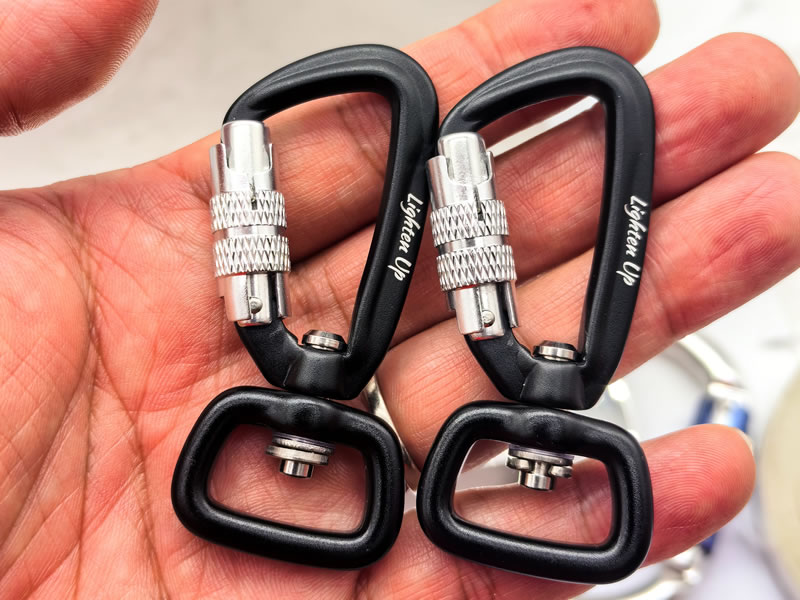Small Carabiner vs Quick Link: Choosing the Right Connector for Safety & Performance
Selecting the correct connector is critical for safety in climbing, rigging, or securing equipment. While both small carabiners and quick links (maillons rapides) join objects, their design and purpose differ significantly. Understanding these differences ensures optimal performance and prevents dangerous failures.

Small Carabiner: Speed & Convenience
- Design: Features a spring-loaded gate for rapid opening/closing.
- Strengths: Ideal for temporary connections, gear organization, keychains, or low-risk anchor points where frequent access is needed. Lightweight and user-friendly.
- Weaknesses:Gate Vulnerability: The gate is the weakest point. Side-loading (force perpendicular to the spine) or gate damage can cause catastrophic failure.Accidental Opening: Can snag and open unintentionally (gate flutter).Lower Strength: Generally has lower load ratings than equivalently sized quick links, especially across minor axes.
- Best For: Non-critical, dynamic applications requiring speed (e.g., clipping gear, dog leashes).
Quick Link: Strength & Permanence
- Design: A solid, oval-shaped link closed by a threaded collar requiring tools (wrench/spanner) to open/close.
- Strengths:Superior Strength: No weak gate. Load is distributed evenly around the solid body. Higher load ratings, especially in multi-directional loading.Security: Threaded collar prevents accidental opening. Resists twisting and side-loading forces.Durability: Robust construction handles harsh environments better.
- Weaknesses:Permanence: Slower to open/close; requires tools. Not designed for frequent connection/disconnection.Installation: Must be properly tightened ("snug-tight") to full engagement; under-tightening compromises strength.
- Best For: Critical, permanent, or semi-permanent connections (e.g., structural rigging, anchor points, winch cables, sailboat hardware, high-load suspension).
Key Comparison Summary
| Feature | Small Carabiner | Quick Link |
|---|---|---|
| Opening | Spring-loaded gate (fast) | Threaded collar (slow, tools) |
| Strength | Lower (gate = weak point) | Higher (solid body) |
| Security | Risk of accidental opening | Very secure when tightened |
| Side-Loading | Vulnerable | Resistant |
| Durability | Moderate | High |
| Use Case | Frequent access, dynamic | Permanent, critical, static |
When to Choose What
- Choose a Small Carabiner If: You need quick attachment/detachment, the load is non-critical, forces are primarily along the spine, and weight/speed are priorities (e.g., clipping a water bottle to your backpack, hanging a light item).
- Choose a Quick Link If: Safety is paramount, the connection is long-term or permanent, loads are high or multi-directional, or the environment is harsh (e.g., securing a tree swing, connecting a winch cable, building a permanent anchor point, marine rigging).
Critical Safety Note:
- NEVER substitute one for the other in a critical safety application.
- ALWAYS check the Working Load Limit (WLL) or Minimum Breaking Strength (MBS) stamped on the device.
- NEVER exceed rated loads.
- Inspect Regularly: Look for cracks, corrosion, gate issues (carabiner), or thread damage/cross-threading (quick link). Retire damaged equipment immediately.
- Tighten Correctly: Quick links must be fully engaged and tightened properly (hand-tight plus tool-tightened as per manufacturer specs).
Conclusion
The choice between a small carabiner and a quick link boils down to function vs. security. Carabiners offer unmatched convenience for dynamic, low-risk tasks. Quick links provide unparalleled strength and reliability for static, critical connections where failure is not an option. Prioritize understanding your specific load requirements, forces, and safety needs. When in doubt, especially for life-safety applications, choose the stronger, more secure option (the quick link) and consult a qualified professional. Never compromise on connector integrity.






